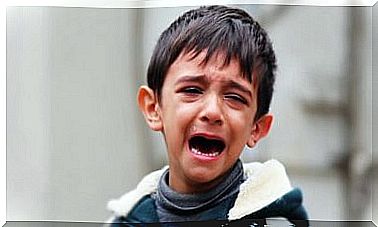The Phases Of Sleep In Babies

As in adults, babies’ sleep is divided into phases. The difference is that adults experience five stages, whereas there are only two stages of sleep in babies.
As can be seen with this differentiation between adults and children, sleep constitutes a specific mechanism and fulfills a transcendent function in people, as well as in other living beings. It is an evolutionary process that develops in line with the rest of the child’s body.
By knowing the phases of sleep in babies, parents can anticipate the needs of children. By understanding the sleep pattern, it becomes clear that trying to modify this natural rhythm is wasted time and also an impediment to the normal development of children.
The five stages of sleep in adults
As the body develops, sleep is prolonged and sustained longer, until it reaches its five phases. Each one of them progresses cyclically in a period of up to 100 minutes. During the night, the cycles begin and end, succeeding each other.
Sleep is divided into Non-REM and REM. Non-REM sleep consists, in turn, of four substages in which the person gradually enters deep and relaxed sleep. The REM phase, called ‘eye movement sleep’, is the shortest and the most active. In this phase, the brain is alert.
To round off the idea, the phases of sleep begin with light sleep that deepens at each stage and culminates in the phase in which the speed of eye movements slows and the brain is gradually activated to enter wakefulness. .
Each of these phases respond to the properly human needs, relative to the age and characteristics of the individual.

Two phases of sleep in babies
For its part, the sleep of babies has only two phases: REM sleep and deep sleep. In this way, sleep repeats itself in cycles lasting about an hour. This rhythm plays a vital role in the development of babies; these are durations linked to feeding, especially in newborns.
In its first months of life, the stomach of the human being is very small. The phases of sleep in babies respond, in this way, to the rapid digestion of milk, the only food up to six months. Therefore, it is logical that every one or two hours, and sometimes less, the baby wakes up hungry.
If the newborn baby had the same sleep routine as an adult, he would not be able to feed, since he would need more time to sleep. The sleep pattern in children, unlike what happens in adults, begins with REM sleep.
Babies remain receptive to their surroundings and can be easily awakened by the slightest noise; then they plunge into the deep phase. At the end of the cycle, the two phases of sleep in babies restart.
What to do if my baby does not fall asleep?
It is common to hear new parents complaining about how little sleep their baby is. Accustomed to the five religiously respected sleep phases, they must adapt their lives to a little being who wakes up crying every two or three hours.
This crying is nothing other than the request for attention and affection. It is not just food: upon waking, each baby demands protection, safety and love from its mother.
Many parents object to taking the baby to another room, where he will wake up alone and may feel helpless from the first months of life. On the other hand, the fact that the little one sleeps skin-to-skin with his mother is the best gift for this stage.

The evolution of sleep in babies
During their first months, babies need a total of 15 to 16 hours of sleep a day. This takes a lot of patience on the part of those around you; This amount of hours of sleep compensates for his constant awakening. The brain of children continues its development, and for this it requires adequate sleep.
After six or seven months, the baby will incorporate more stages of sleep. However, the process of implementing them will take time and patience.
After one year of life, children experience ‘micro-awakenings’, as a natural response to alertness. Although over time the dream becomes more consecutive, mothers and fathers should know that only at three or four years will children have acquired and applied all the phases. That is, they will be able to sleep without interruptions.
In short, patience, support and loving accompaniment are the most valuable gift that a father or mother can give while developing the sleep phases in babies. Remember that everything is part of its maturation process, of which you are an essential part.










